How the Millennium Falcon became the most famous spaceship in cinema
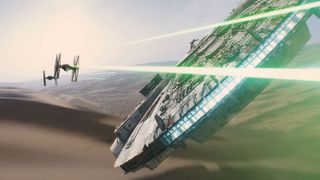
If ever a spaceship became synonymous with a screen character, it’s the Millennium Falcon. Just as veteran Star Wars space-pirate Han Solo makes his eagerly anticipated return in The Force Awakens, so too does the ship that famously made the Kessel Run in less than 12 parsecs. But the iconic bucket-of-bolts may have lost some of that essential appeal had its original, far more conventional design been brought to the screen back in 1977... "The first concept was felt to look very similar to another ship seen on the TV series Space: 1999,” says Roger Christian, the Oscar-winning set decorator behind Star Wars: Episode IV – A New Hope, who was tasked with the construction of the Falcon. “I think George [Lucas] accidentally said ‘make it like a hamburger!’ which was his favourite food at the time.”
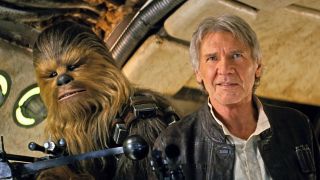
Production illustrator Ralph McQuarrie’s originally linear Falcon design was instead modified into the Rebels’ Blockade Runner, Tantive IV, the first ship seen entering the Star Wars universe in A New Hope. In fact, the only noticeable design aspect that was utilised from McQuarrie’s original concept was the cockpit, which derived from the Boeing B-29 Superfortress – a fighter plane used in World War Two. Significantly, McQuarrie’s Falcon realigned that cockpit from a conventional front positioning to the rather irregular side of that “half-eaten hamburger” design. “I think that was great – it created a ship that had never been seen before or since and that round shape has become a very iconic kind of image,” reflects Christian.
From McQuarrie’s painting, miniature effects illustrator and designer Joe Johnston drew further sketches and made a miniature model, enabling the design process to evolve further. “He laughs about it now because it was literally making a hamburger into a ship!” says Christian. “We never met because we were on two different sides of the Atlantic and there wasn’t email. We’d just get a package once a week and we’d look and go, ‘Oh my god this is what we gotta build!’ and we’d send back drawings. That’s how it was done in those early days.”
And it was from Johnston’s model that the set decorator inherited an apparent defect that was nevertheless built into the ship. “Joe was constructing the model and he saw a piece he didn’t like and knocked it off - but we inherited that and it got built full size,” he reveals. “There’s a piece of the Falcon that’s actually like bad glue, although you wouldn’t be able to tell now. Joe now says, ‘You built our mistake into the full sized ship!’”
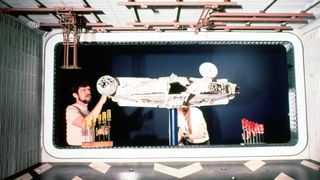
Essential to the distinctive design and feel of the Falcon was achieving a lived-in look that was light years away from the clean-cut aesthetics of spaceships seen in countless films and TV shows. “George said the Falcon had been repaired and repaired and broken down numerous times, and that Han had no money so he constantly stuck bits onto it and bought second-hand parts to somehow keep it going,” reveals Christian. “It was like having an old racecar that’s still really fast and could do everything but it was on faith and string. We were never given the age of the Falcon but we knew it was older than Han and that it had been through the wars – so that was our take on it. It was the first thing in the film that looked really aged and set the tone for everything.”
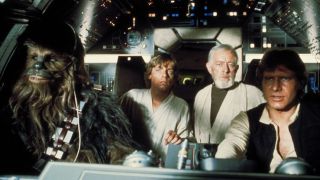
Oscar-nominated art director Harry Lange, who was behind the interiors on Stanley Kubrick’s epic 2001: A Space Odyssey, was appointed to work on the Falcon’s cockpit. “He created the panels and switches slightly (like 2001), was done, and then I came along and fucked it all up to give it the Star Wars look!” laughs Christian. “It would’ve been too clean but it was a good basis. I put in pipes and bits of dressing to try and personalise it. The exterior had to look used and pretty beaten up, and the cockpit had to be a fantasy that you felt could work.”
That personalisation included the now blink-and-you’ll-miss-it inclusion of some infamous chrome hanging dice. “I was trying to personalise the cockpit and I said to George that I noticed he put dice in Ron Howard’s car in American Graffiti, which was a hit film, so placing hanging dice in the Falcon was both to bring good luck - and because it’s Harrison Ford, and it’s exactly what Han would do,” says Christian. “George agreed to it. Only later did I find out that [cinematographer] Gilbert Taylor eventually took the chrome dice down and they never got put back, so if you see the film they’re actually only in there for a couple of early shots – then they’re gone!”
Sign up to the SFX Newsletter
Get sneak previews, exclusive competitions and details of special events each month!
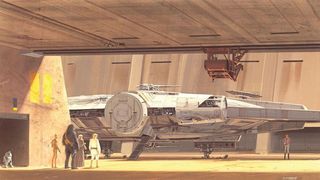
However, one talented eagle-eyed fan did notice Christian’s chrome dice and as a result they’ve been incorporated into the Falcon’s cockpit for The Force Awakens. “I did a Reddit session recently and told them the dice story and immediately we received an email to say, ‘Go get the Vanity Fair cover now and look at it – your dice are there!’” explains Christian. “Apparently JJ Abrams had seen them and asked one of his assistants to go on eBay and they managed to track some down so he’s put them back in the Falcon. That’s really something!”
Intriguingly, Christian has been in touch with one of the art directors behind The Force Awakens, who compared his experience working on the iconic ship. “He said, ‘You know, I’m doing what you did 38 years ago – but the difference is I get drawings and have to do it exactly as it’s drawn, whereas you just went ahead with scrap and laid it in organically. To be honest I prefer your way!’ So I think they were using the same techniques but they had the experience of all the films to draw on.”
Of all the sets he decorated for the Falcon, Christian is particularly proud of the Main Hold area, featuring the holographic table where R2-D2 hilariously beats Chewbacca at an intergalactic version of chess and where Luke begins his Obi-Wan tutored lightsaber training. “I think that’s my best set, it took at least six weeks to dress and I love that kind of aged, real science fiction look,” he reflects. “My intention was to cover the walls entirely like a Russian submarine. This is how I imagine a craft like the Millennium Falcon would be, like a large version of an Apollo capsule. There were no space stations then to reference, just military bomber cockpits, so really I made it all up from my own imagination.”
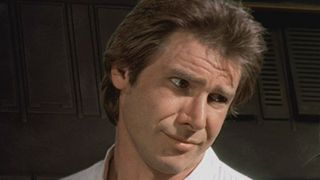
Another instrumental part of the Falcon was the gunner station, where Luke and Han fight a squad of attacking TIE fighters after fleeing the Death Star. “That was all built already and didn’t need to be dressed,” reveals Christian. “Norman Reynolds [an additional art director] did all the drawings for that one and he was very good at how mechanical things could work. Everything was very carefully engineered because Harrison Ford and Mark Hamill were throwing themselves around in there and it had to be safe for them.”
But did Christian have any inkling at the time that Star Wars would become so iconic? “I was certainly aware that I was watching something truly unique being made,” he reveals. “Not that I knew it would probably become the most famous film in the history of cinema, but I knew it would work if it could get out there and be seen. None of us were sure it would get out there. We literally had nothing to go on apart from blind faith, experimenting and a belief it would work.”
It certainly helped that the celebrated set decorator was totally in sync with the notoriously tight-lipped director. “I just knew what George needed and was lucky I shared an identical vision,” continues Christian. “I love myth and understood what the film was about and I love that kind of aged science fiction. In the end this vision of his worked and he pulled it off.”
Click here for more excellent SFX articles. Or maybe you want to take advantage of some great offers on magazine subscriptions? You can find them here.
I'm the Editor of SFX, the world's number one sci-fi, fantasy and horror magazine – available digitally and in print every four weeks since 1995. I've been editing magazines, and writing for numerous publications since before the Time War. Obviously SFX is the best one. I knew being a geek would work out fine.
Most Popular



